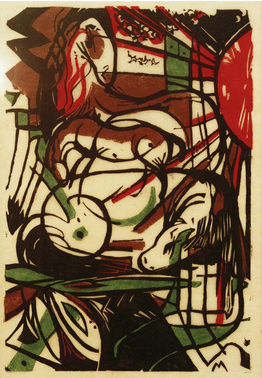Birth of the Horses (Geburt der Pferde), was created in 1913 by Franz Marc, a German Expressionist Painter, who lived from 1880-1916. He was a founding member of Der Blaue Reiter (The Blue Rider), a Munich group of Expressionist painters
Franz Marc specialized in painting animals and was draw to them from early on in his career. Birth of the Horses is kept in the Ball State Museum of Art, Indiana.
Many of his paintings are housed in museums worldwide including several across the United states. Some of his almost Cubist portrayal of animals were made in woodcut and lithography.
He believed the horse to be a powerful symbol of nature, energy and grace and he attempted to explore feelings that had never been explored by his forefathers in the world of painting.
He painted many pictures of horses, including Leaping Horses (Springende Pferde) which is unique because he attempted to apply divisionist or pointillist techniques in this work. In his paintings Franz March likes to unify animals with the landscape. By using an undercurrent of abstraction he brings form and colour together. There is a similarity between this painting and Neo-Impressionist Paul Signac who also used pure colour in block like marks.
His use of colour also stems from viewing and exhibition of the highly coloured work done by Vincent Van Gogh and the influence of Cubist Art.
He is particularly famous for the production of paintings that are of curvaceous horses, boldly coloured in richly expressionist yellows, reds, blues and mauves. These animals are always located in abstracted, flowing landscapes. Large Red Horses (1911) is another much reproduced example of this. There is no joy or calm conveyed in the diminutive and contorted poses of the iconic painting the animals – deer and horses.
The contrasting explosion of colour seems to completely overwhelm these creatures. Some say this work portrays the war to come and may even be prophetically representing the artist's death in battle with the brownish film (suggestive of blood) covering one area of the painting.




